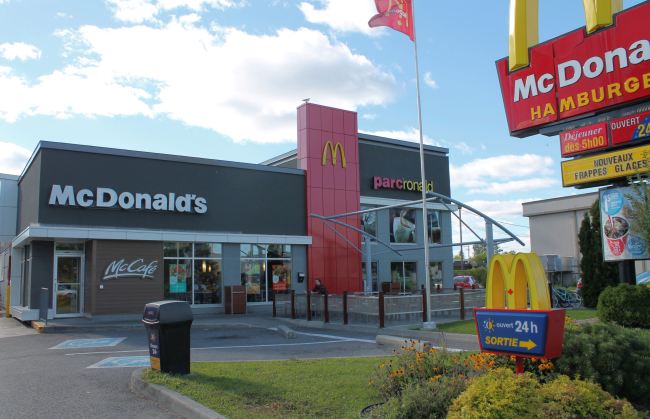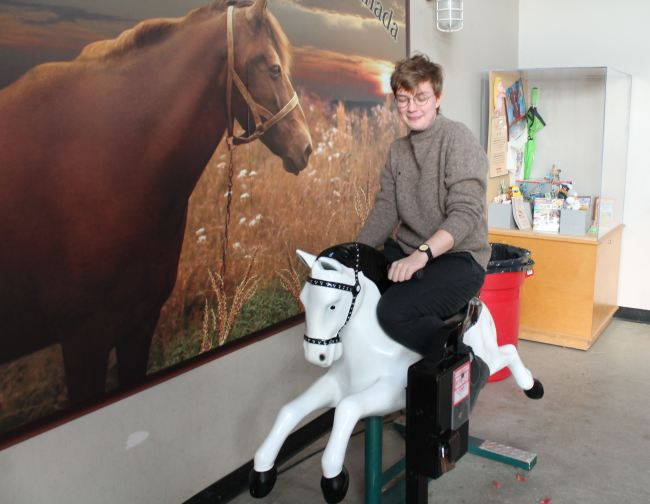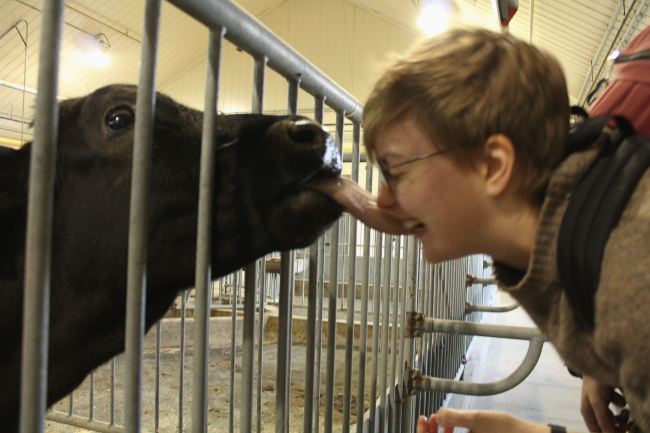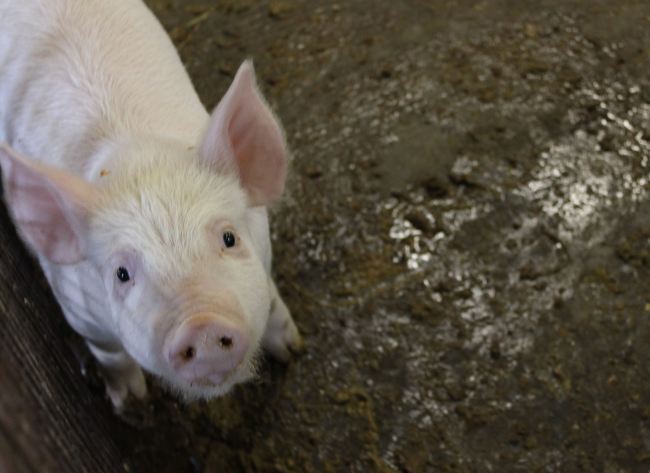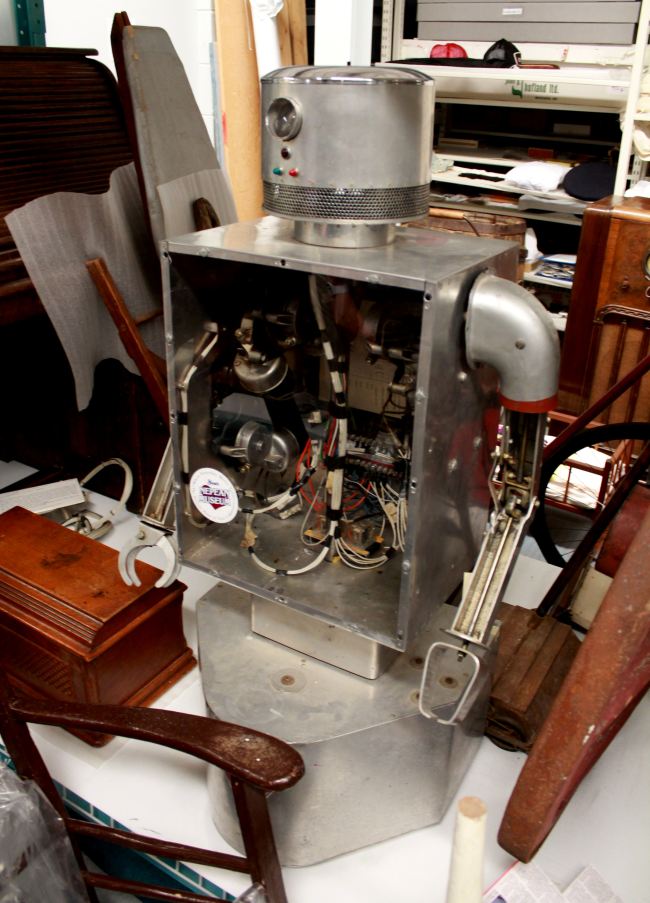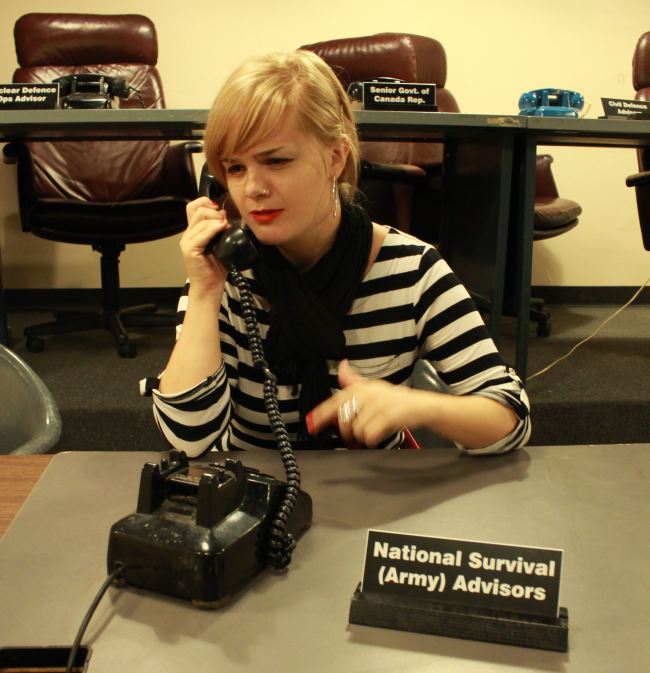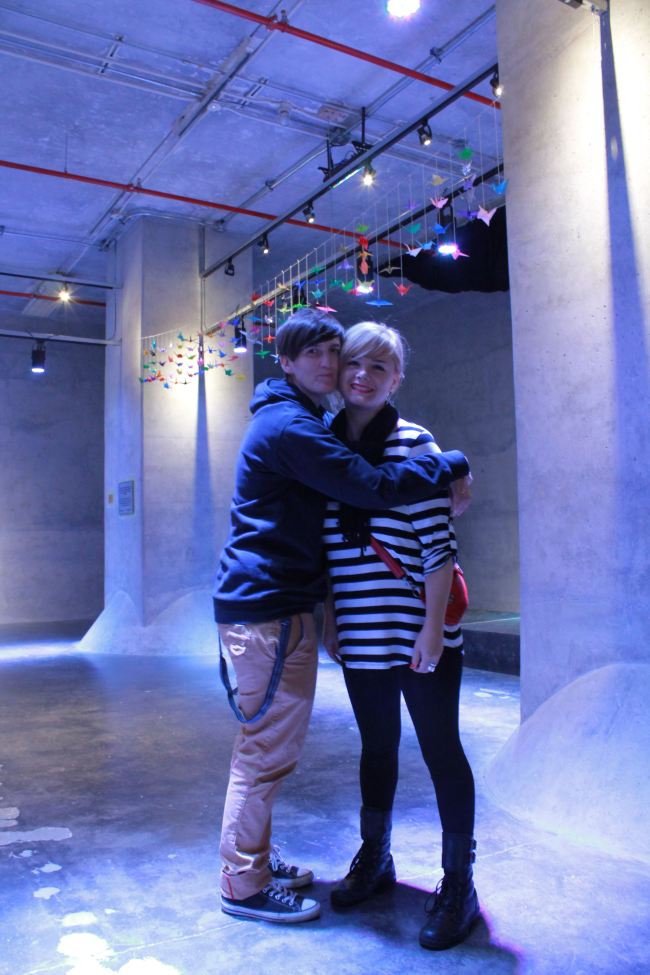//embed.scribblelive.com/Embed/v5.aspx?Id=1498695&ThemeId=3496
Homegrown candidate battles racism on the campaign trail
Toronto City Council candidate Saeed Selvam spoke to voters from the same stage where, years ago, he ran for student council president. But he still faces preconceptions that he’s not from around here – or worse – simply because of his race.
The Ward 17 candidates debate at Oakwood Collegiate Institute on October 9th felt “nostalgic” for first-time candidate Saeed Selvam. The first time he debated here, as a high school student, he remembers it went pretty rough.
“At the first assembly I got booed,” says Selvam.
But he managed to turn things around and win the race.
Now running for city council, Selvam is facing tougher issues and seasoned opponents. The race is a rerun of two close matches between three-term incumbent Cesar Palacio and Alejandra Bravo, who lost by only 281 votes in 2006. During the debate, the two were at each others throats, with Bravo slamming Palacio’s Ford connections and “tea party politics” and the councillor criticizing her “negative” campaign. Palacio has threatened to file a defamation lawsuit against Bravo, claiming one of her volunteers passed out an allegedly inaccurate pamphlet that criticized him for voting against library funding.
Selvam decries all the “dirt slinging,” which sometimes reminds him of his high school days.
“You still have heckling from the crowd,” he says. “The more things change the more they stay the same.”
But the “dirt” being thrown at Selvam has gone well beyond the ordinary sort of campaign negativity. In an election season that’s already seen Olivia Chow told to “go back to China,” racism is now marring the Ward 17 race.
“Yesterday on twitter I got accused of being an extremist,” says Selvam, “just because I’m a person of colour running.”
On Wednesday, a twitter user with the handle @BeBeaches asked an inflammatory question about Selvam: “is this MOSLEM JIHAD2 infiltrate politics&instill SHARIA LAWS?” The tweet has since been removed, but Selvam captured a screenshot.
While this may be the most vicious comment yet, Selvam also faces more subtle forms of prejudice while on the campaign trail. Many question whether he’s from Canada at all. In fact, he’s the only one of the three major candidates who was born in the country, a confusion Selvam calls “irony.”
Positioning himself as the non-aligned candidate in a polarizing race, Selvam talks up his ability to work with people of all political stripes.
“You need to be able to build bridges rather than burn them,” he says.
Often pegged as another progressive candidate splitting the left-leaning vote with Bravo, Selvam also tries to emphasize his appeal to those on the right. Speaking to a resident who was thinking about voting strategically, he pointed out how he tries to strike a balance and offer alternatives.
“I believe in being socially progressive, but also smart with money,” says Selvam.
Before running for council, Selvam served as executive director of the non-profit SPARK initiative. He was also campaign manager for the transportation campaign CivicAction and director of youth-police relations at the Toronto Youth Cabinet.
Hushed up corruption scandal shows (again) why we need Wikileaks
Wikileaks has released a secret Australian gag order blocking all reporting on a massive corruption scandal implicating foreign heads of state and Australian central bank officials. The court justified the censorship measures, which Wikileaks founder Julian Assange called “the worst in living memory,” by appeal to “national security” interests.
The gag order is surely one of the most blatant recent examples of censorship by an established democracy, but has received only limited attention in the Western press.
Issued by the Supreme Court of Victoria on June 19th and publicized on the Wikileaks website last Tuesday, the order forbids “disclosure, by publication or otherwise, of any information…that reveals, implies suggests or alleges” that any of a long list of prominent individuals received bribes or abetted illegal activity. The restrictions apply to “any current or former Prime Minister of Malaysia,” the current Presidents of Indonesia of Vietnam, a number of their relatives and several cabinet level officials implicated in the case. The court also censored the Australian media from discussing the contents of the gag order itself.
The scandal dates from 1999, when representatives of two subsidiaries of the Reserve Bank of Australia channeled millions of dollars in bribes to foreign officials in order to secure lucrative contracts to print polymer banknotes, according to reports in the Jakarta Globe and the Malaysian Insider. The case came to light in 2009, when Australian and Malaysian authorities initiated investigations which led to the secret indictment of 17 Australians. Charges were also filed against at least three Malaysians.
Governments have long cited “protection of national security” as a convenient pretext for hushing up potentially damaging revelations. The secret Australian court order went on to admit that its purpose was “to prevent damage to Australia’s international relations that may be caused by the publication of material that may damage the reputations” of the foreign officials specified, reflecting an extremely broad interpretation of the concept of national security, to say the least.
Reacting to the leak, Wikileaks founder Julian Assange, who remains trapped in the Ecuadorian Embassy in London, stated that “the concept of ‘national security’ is not meant to serve as a blanket phrase to cover up serious corruption allegations involving government officials, in Australia or elsewhere. It is in the public interest for the press to be able to report on this case, which concerns the subsidiaries of the Australian central bank.”
The Australian government defended the measure, telling the Jakarta Globe through its embassy that it “obtained suppression orders to prevent publication of information that could suggest the involvement in corruption of specific senior political figures in the region — whether in fact they were or not” and that it “considers that the suppression orders remain the best means for protecting the senior political figures from the risk of unwarranted innuendo.”
While South-East Asian media covered the scandal and subsequent cover up, as did the Times of India and Russia’s RT, few reports could be found in the West, with the notable exception of the Guardian and a short piece on CNN. This despite the fact that the court order applied only in Australia. Foreign publication of the censorship measures could have helped break the veil of secrecy in Australia, given the significant interpenetration of English language media systems.
In any case, all this illustrates the benefits of occasionally perusing the Wikileaks website for direct and unfiltered access to confidential documents of significant public interest. Other recent leaks published on the site include secret drafts of trade agreements with wide ranging implications for the environment, intellectual property rights and the financial services industry. As usual, these treaties are being negotiated behind closed doors with little public consultation or transparency.
We all have a vital interest in closely monitoring what our governments are doing in our name, particularly when they see the need to keep their actions secret. Wikileaks has again shown that it is a powerful tool in helping us break through the walls.
See the Wikileaks press release here:
https://wikileaks.org/aus-suppression-order/press.html
and a PDF of the court order here:
The world of capital vs. the world of the humans – two scenarios
After a long hiatus of tramping around the Austro-Hungarian Empire, I’m back in Canada and ready to start blogging again. I may go a bit lighter on the quirky exposés for a while, as I’m now planning to use this blog more as a platform for my socio-economic grievances. I might still post pictures of a cat show I recently covered, but don’t expect the kind of earth-shattering breaking stories about petting zoos and gym-jams that you’ve gotten used to.
I’ve been thinking a lot about how imbalanced our international economic system is right now. Globalization obviously offers incredible possibilities – to travel, to learn, to innovate – but also unacceptable abuses and inequalities. If we want to have the good, do we have to take the bad along with it? If we want to fight inequality and preserve the welfare state, do we have to build economic walls around ourselves?
Consider two scenarios:
A. Wealth is free to move from one end of the earth to the other, chasing the highest return to investment. Nation-states compete to offer the most attractive “investment environment” – cheaper labour, privatized public services, corporate subsidies, flexible regulatory frameworks. Immigration laws keep humans stuck where they are, forcing them to adapt to the world of the corporations.
B. Humans are free to move from one end of the earth to the other, choosing whichever country best provides for their needs and personal goals. Nation-states compete to offer the most attractive living environment – more public spaces, healthier air, better jobs, stronger social solidarity. Regulation keeps wealth more or less where it is, forcing it to serve the world of the humans.
Both of these worlds are clearly “globalized,” but involve a completely different distribution of power and freedom. The real world certainly combines some degree of these two ideal types. But I think it’s clear enough that our political leaders have opted to favour one over the other.
Wouldn’t things have been so much more beautiful – so much more human – if we had forced them to choose differently?
The really scary thing is that we are quickly losing the ability to choose. Globalization – which today overwhelmingly means the globalization of capital – has made it more and more difficult for states to make decisions independently of each other. Our “leaders” can easily claim that they need to adapt to stay competitive, that decisions can’t be made without taking into account the inevitable reactions of world markets.
Only thirty years ago we had an economy that was roughly coextensive with the limits of our democratic communities – it shared borders with our nation, our electoral institutions, our public sphere. But now the economy has outstripped those borders, while our Parliaments, our media and our people have stayed pretty much where they are. How do we bring the balance back?
Nation-states, still the most natural political communities, could start clawing back control of the economic activity taking place in their own borders, empowering their citizens to choose the kind of society they want to live in. The only way to do this is through reestablishing some kind of control on capital movements – ideally through multilateral instruments like a worldwide tax on financial transactions – but if need be on a strictly regional basis. This strategy is undoubtedly part of the ideal solution, but it has its drawbacks.
The world economy isn’t all bad. In terms of economic efficiency and consumer choice free trade and investment are definitely a plus. Interdependence may even have even played a role in forcing states to put aside their political differences and cooperate in pursuit of their common interest, favouring peace. Even if we admit that things have gone too far, it would be irresponsible to throw all of this away.
What we need is not the end of globalization, but a new globalization – a more human globalization.
If we want to preserve the advantages of economic openness then we can’t completely close our borders. But, if we want to balance the nefarious effects of capital mobility, other kinds of mobility need to go further.
There is a broad consensus among economists that free movement of people would increase worldwide wealth dramatically, far more than any new trade or investment deals. Migration would also reduce international inequality by evening out the distribution of unskilled labour. Everyone benefits (assuming government support to compensate unskilled labour in rich-countries), but especially the poor. And let’s not forget the horizons less restrictive immigration opens up to all of us for mutual understanding and personal growth.
Public spheres and news agendas are still fundamentally national in character, even as the issues that really matter – climate, conflict, economics – are increasingly international. As citizens, if we want to be able to influence how these issues unfold and hold the international organizations responsible for dealing with them to account, we need to be able to discuss the same issues in the same terms. The key institution here is of course the media, which needs to focus less narrowly on national interests, develop more transnational links with other public spheres and treat issues from a more international perspective.
Lastly, we need to make international organizations more democratic. While a world parliament is admittedly a Utopia, we need to constantly insist that institutions like the IMF, the World Bank and UN agencies strive towards transparency, responsiveness and accountability – and not just to disjointed national interests, but to humanity as a whole.
We’ve been racing toward the world of capital for the past thirty years, and the world only feels less secure, less controllable, less… human. Isn’t it time to start building a different world?
————————————
Up next: my review of Thomas Piketty’s Capital in the 21st Century. The sexiest read of the summer!!!
What to do with the Senate: an Athenian model?
After years of disinterest, scandal has finally prodded politicians, lawyers, pundits and the like into discussing what to do about the embarrassment that is the Senate. First conceived of as a bulwark to protect class privilege, the Senate is now a kind of political garbage heap, where the governing party can toss cronies and party hacks, rewarding them with lifelong pensions and bottomless expense accounts. As an archaic, unelected institution plagued by scandal, the place has about zero democratic legitimacy.
Nonetheless, I haven’t been particularly inspired by many of the reform proposals currently making the rounds. Province wide consultative elections have been on the Conservatives’ backburner for the past decade or so. While this would certainly give the Senate the accountability and popular mandate it so sorely lacks, it would likely repeat the disfunction we see in the House of Commons. Large scale elections inevitably become dominated by political parties. While parties are a necessary means of mobilizing and channeling support in a democratic society, they also lead to divisiveness and impede rational, objective debate. An elected Senate might only add yet another layer of partisan squabbling, perhaps leading to the kind of impasse we see in the American congressional system. Hardly a strategy for bringing about the objectivity fitting for a House of “sober second thought.”
Just abolishing the whole mess has long seemed the only way out to me. While the Senate does play some role in assuring regional representation (at least in principle) this seems somewhat less pressing in a federal system where the provinces have considerable autonomy. Still, one increasingly obvious democratic deficit of our system has made me more skeptical of abolition: the centralization of power in the hands of the Prime Minister. With a majority of seats in the House, Mr. Harper has virtually total control over the executive and legislative branches of government. He is pretty much impervious to anything the opposition does to, well, oppose him. For five years at a time, a majority government can operate more or less as a dictatorship, subject only to the limits of the constitution.
Constitutionally, the Senate could act as a check on the unrestrained power of the Prime Minister’s office, if only it had the democratic legitimacy to impose its will. Ideally, it should also remain non-partisan. In a system with a strong tradition of party discipline, domination by political parties would turn Senators into lackeys of the Prime Minister or bring about American style gridlock.
A proposal I recently heard on a CBC call-in show suggested one way to achieve this delicate balance between democracy and the neutrality. Senators, so the proposal goes, should be chosen at random from the ranks of ordinary citizens.
While this may seem rather original, the idea has at least one illustrious model to draw on: fifth-century Athens. History’s best embodiment of the ideal of direct democracy and citizen participation, the Athenian state chose most of its public officials by lot (with slaves and women excluded, of course).
What could be more purely democratic than a representative sample of ordinary citizens influencing policy, not through polling or focus groups, but through actual deliberation and decision making? Next to a House dominated by lawyers and businessmen, we could have a Senate composed of teachers, nurses, tradespeople, students and the unemployed, a Senate more likely to pay attention to the problems of real people. We could even let women participate and not have any slaves.
Selection need not be totally random. A nomination system could be devised to ensure that potential candidates enjoy the confidence of their neighbours and associates, with the number of required signatures kept small enough to avoid the need for large scale mobilization efforts. This process would create a large pool of suitable candidates who could be chosen according to a selection process taking account of factors like occupation, region, gender and group affiliation.
This is certainly not a new idea. It is similar to the idea of “citizens’ assemblies” that have been proposed by the NDP and Québec Solidaire. Such bodies are usually only meant to be consultative, however. The major advantage of using the Senate is that it is invested with wide ranging consitutional powers that could directly challenge the government.
All this may be very unlikely to actually happen. Political parties are sure to object to the creation of a power center beyond their control. But it is an idea that seems to offer a way of bringing citizens into the decision making process of governing and creating a counterbalance to an all-powerful Prime Minister. It would completely revaluate what was meant as a symbol of class privilege and elitism.
Speaking of which… why not do the same with the Monarchy? Everyone could be King or Queen for a day!
Review : Parc Ronald – 80 boulevard Gréber, Gatineau
Forever a golden opportunity for parents to get their children to shut up and let them eat in peace, McDonald’s playplaces have long been the perfect complement to a happy meal. Accompanied by a family with two little girls and a teenager, I set off to Gatineau to visit the francophone equivalent: “Parc Ronald.”

For the few of you that don’t know, McDonald’s playplaces are essentially mini versions of Gym Jam open to all patrons under a designated height in select McDonald’s restaurants. I’ve wanted to review a playplace for a long time, since they’re both tantalizing and taboo for anyone over 15. I really want to play in the ball pit, but know I can’t without crossing all sorts of social boundaries.
It was essential to bring along a group of children for the review, both to get a representative sample of the intended client base and to avoid just lurking around alone looking creepy. I contacted my friend Mik and he rounded up his two sisters, Mieka, 7 and Zoé, 13, and his niece, 3 year old Nyssa, who proved to be eager and discerning reviewers.
After consulting Google maps, it turned out that playplaces are much rarer than I imagined. I was only able to locate four in the Ottawa area. We decided on a Parc Ronald in a rather skeezy part of Gatineau, 80 boulevard Gréber.
Inside we found a single play structure with a covered slide, a tower, a few spherical bubble chambers and two segmented tubes. There was no ball pit.
Mieka told me that she has been to this Parc Ronald before and has always had a positive experience. “I think it’s one of the good ones,” she says.
This time was no different. Mieka and Nyssa spent more than an hour crawling throughout the structure, breaking only to consume their happy meals, unwrap their toys and update me on what was going on inside. Zoé spent more time with the adults, but ventured in occasionally to join the others.
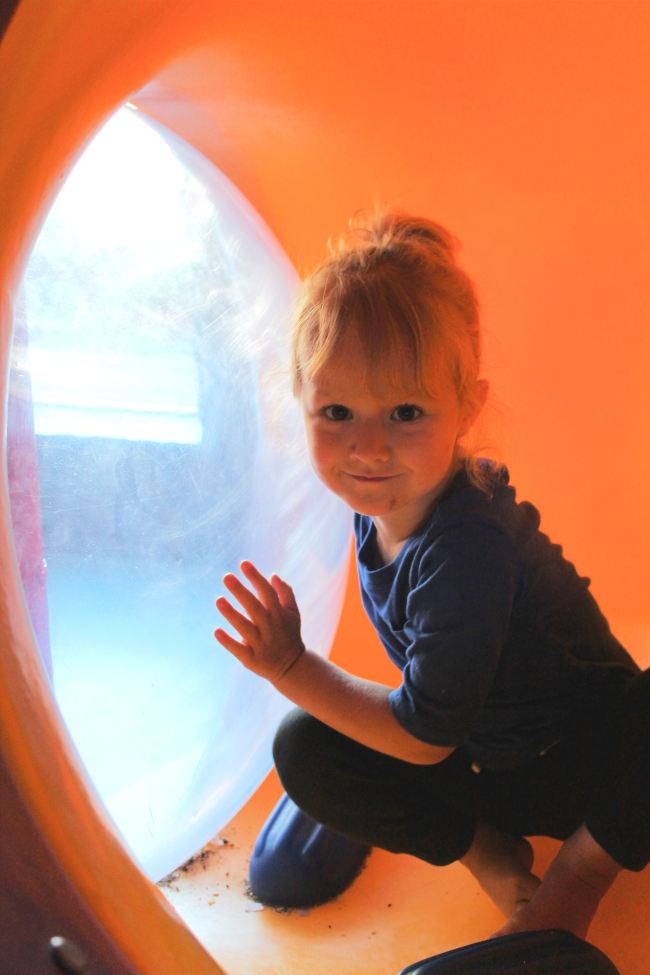
All in all, both Nyssa and Mieka rated the fun factor of their experience as astronomically high. Asked to place their level of enjoyment on a scale of most favorite to least favorite food Nyssa rated it equivalent to spring rolls while Mieka put it on par with spaghetti. In both cases, this was the highest rating possible. They agreed that the purple coloured spherical section on the near right was the raddest place to be. Zoé gave her experience a more modest but still positive rating, perhaps reflecting the approximate age ceiling at which playplace related fun begins to diminish.
The girls did have a few criticisms. Mieka mentioned that there are significant traffic buildups in some parts of the structure, especially around the bottom of the slide. “The slide opening is like a grouping zone,” she says, “everyone wants to be there.” This can even become hazardous as other kids come barrelling down. Still, Mieka believes that tragedies can be avoided with a little bit of foresight and good communication. “Well yeah, it’s dangerous… but if you scream you’re there it’s not very dangerous.”
Mieka also cautions that the structure may be too challenging for younger children. “It’s not great for little kids,” she says, “they’re scared to climb all the way up to take the slide and sometimes just sit at the bottom of the slide, which is dangerous.” In fact, it did take some time for Nyssa to build up the courage to go down the slide. An even younger girl broke out into tears at the prospect of climbing up the tower.
Zoé’s concerns focussed more on the sanitary conditions of the playplace. “Sometimes when I used to play here it was like dirty and gross,” she says. “Like once someone threw coke on the slide and it was all sticky and gross and they didn’t even clean it.” This is a particularly serious issue given that children are required to be barefoot at all times, and often have little room to manoeuvre around spills or stains.

Before we left, Mieka and Nyssa tried to persuade me to try it out for myself. I decided that I would never be a real journalist if mere social conventions were enough to deter me from going into a Parc Ronald. So after warning all other parents that I would not, under any circumstances, photograph their children, I crawled up into the tower. Sometimes it was a bit cramped, but navigating the network of tubes was something of an adventure. I found a range of games and challenges. Mieka trounced me in a game of tic-tac-toe and I felt really bad about it. Then I went down the slide and felt a lot better.

Soon it was time to go. Mieka and Nyssa were pretty disappointed, and to be honest, so was I. I wouldn’t say that it’s anywhere near as good as a Gym-Jam, but it is basically free and fun for immature people of all ages.
What is Ottawa’s most Underrated Museum?
Between the National Gallery, the War Museum and the Museum of Civilization, the national capital area is home to some of Canada’s showcase museums. If you’re an Ottawa native, you’ve probably visited all of them on innumerable grade school field trips. Is there anything left to see? Amongst all the community and niche museums, bereft of federal funding and ignored by tourists, I set out in search of Ottawa’s hidden gems.
Canada Agriculture and Food Museum
Admittedly, the Agriculture and Food Museum is owned and financed by the federal government and grade school classes do occasionally go there for field trips. I still decided to include it in this article, partially because none of my classes ever got to go. Whenever I remember that it even exists, I imagine that it’s pretty much just a glorified petting zoo for little kids, or some kind of graveyard for old farm machinery. I assume that most people between the ages of 7 and 65 are deterred by similar assumptions. But could we all be wrong?
I brought my friend Finch along to help with the review. If there’s anyone who should be exhilarated by agriculture it’s Finch. They grew up watching Little House on the Prairie and their favorite part of fall is viewing the crow migration. Farming, and especially everything having to do with horses, has always been one of their “suburban fantasies.”
Admission is free after four O’clock. Since we are charming and poor and very good at laying guilt trips on the admissions lady, it’s actually free after 3:50 for me and Finch.
Our first stop was the large animal barn. Signs on the entrance door rather impolitely warned: “DO NOT FEED THE ANIMALS. DO NOT TOUCH THE ANIMALS.” There weren’t any staff in the barn, or virtually anywhere else in the museum. The downside was zero ability to pose questions. The upside was complete and utter freedom to touch and feed pretty much whatever we wanted.
We spent some time touching Merill, a Clydesdale horse and October’s “animal of the month.” Then we touched some cows. Cows are more adorable and affectionate than I ever would have thought, and we quickly formed bonds of friendship with Emma and Villa. Both enjoy licking people wherever they can, which included my coat and Finch’s face. According to Finch, their tongues are rougher than a cat’s but much slimier.
In the small animal barn we found sheep, pigs and poultry. A large litter of piglets were extremely interested in our cameras, nibbling on Finch’s hands and walking around in their own filth. The barn also housed a “restaurant” known as the “harvest hall,” which somewhat oversold what is essentially eight plastic picnic tables and some vending machines.
Outside is an interactive exhibit on renewable energy sources used in agriculture. You can have a water pumping race with a windmill or steer a solar powered farm vehicle. The learning centre features exhibits designed to explain where our food comes from. An important limitation was the complete failure to discuss the living conditions of the animals that end up in the grocery stores of the nation. The agriculture museum is a happy place, full of happy animals. This is not the case everywhere else, and the museum does nothing to promote awareness of this unfortunate fact.
Even if the information provided is less comprehensive than I would have liked, touching, feeding and being licked by animals in a fully functioning farm did make me feel more connected to where my food comes from. The agriculture museum is a glorified petting zoo, so long as you’re willing to bend the rules a little bit, but I strongly encourage everyone to rethink their assumptions about the appropriate age ceiling of petting zoos.
The Nepean museum
A good representative of a small community oriented museum, the Nepean museum chronicles the history of one of Ottawa’s pre-amalgamation suburban sister cities. The last time I went was about twenty years ago, and all I remember is that they had a cool robot for no apparent reason.
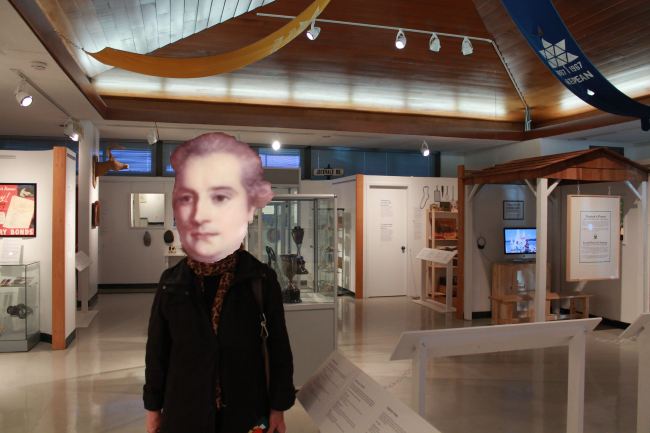
Due to her refusal to appear on the internet, my mother’s face has been replaced with that of Sir Evan Nepean.
I brought my mother along to help me with the review, since, as a 30 year Nepean resident, she fits nicely within the target audience. Despite this, she rated her expectations as “not much.” It actually took a lot of whining to convince her to come at all.
Located in an obscure park off Meadowlands drive, the museum itself is really just one big room. No other visitors were there for 90 percent of the hour and a half we spent viewing the half dozen exhibits on offer. Beginning with a showcase of agricultural equipment from the community’s rural past, we moved on to a collection of period headwear, featuring the hats of Ida and Lois Long, two illustrious Nepean women of the turn of the century. Unfortunately, we were forbidden from dressing up in any period garb, and limited to reproductions that were often completely irrelevant, including a hard hat and a jester’s hat.
My mother was particularly taken with a re-creation of a period parlour, whose highlight was a patriotic pillow embroidered by one of the Longs. I spent much of my time reading about Sir Evan Nepean, the colonial governor who gave his name to the area. I was surprised to learn that Sir Evan never actually visited Canada. Not even once. One of the curators explained to me that he was just best buds with the guy who got to name the place when it was a big forest.
The curators were friendly and helpful. They even took me to the back to see the robot, who had been banished to the store room due to his complete incongruence with any of the current exhibits. High points for nostalgia.
The museum was relatively informative and well presented, but, apart from the robot, the subject matter didn’t exactly make for an exhilarating experience. Although this was not exactly a difficult feat, I should mention that it did exceed both mine and my mother’s expectations.
The Diefenbunker
Located in a decommissioned underground fall-out shelter in Carp, the Diefenbunker is Canada’s cold war museum. The facility was constructed in the early 60s under Prime Minister John Diefenbaker to house government functions in the event of a nuclear attack on the capital. It’s now open to the public, offering guided tours through a labyrinthine maze of tunnels filled with period decor and exhibits. They also do weddings, laser tag and children’s birthday parties.
For this one I brought along the extraordinary Jenn and Joanna. Given the combination of cold war insanity and the best in sixties office design, our expectations were extremely high.
But these high hopes were very nearly dashed. We only made it into the sold-out tour group because I mentioned I’m a journalist and they took me way more seriously than they should have.
Our tour guide was Cassie, who began by briefly encapsulating the history of the facility. We entered through the loading building, which housed three decommissioned nuclear weapons and a map showing the probable effects of a 1 megaton air blast over CFS Leitrim. My neighbourhood would have suffered casualties in the 5-15% range. Riverside South would have been totally annihilated.
After traversing a long tunnel, Cassie led us through heavy vault doors and into the “decontamination room.” According to official procedure, all 535 public servants, military officers and support staff on the guest list had to shower with their clothes on, which would then be taken and incinerated. A second shower was then required, followed by testing for radiation contamination. If their levels were deemed dangerous, anyone, even Diefenbaker himself, was to be cast out into a barren post-apocalyptic wasteland. Since their clothes would already have been destroyed, and no replacements were mentioned in procedures, they presumably would have wandered around naked before succumbing to a horrific death. No mercy.
Next we were in the fall-out shelter proper. The first stop was the medical clinic. We might expect the inhabitants of the bunker to experience intense psychological trauma at the thought of dying loved ones and acute feelings of hopelessness at the prospect of a desolate and bleak future. 30 days underground wouldn’t have helped either. Nonetheless, no psychologists or psychiatrists were provided for, and the only treatment envisioned in the case of mental illness was confinement to an isolation room. Call it the spirit of the times.
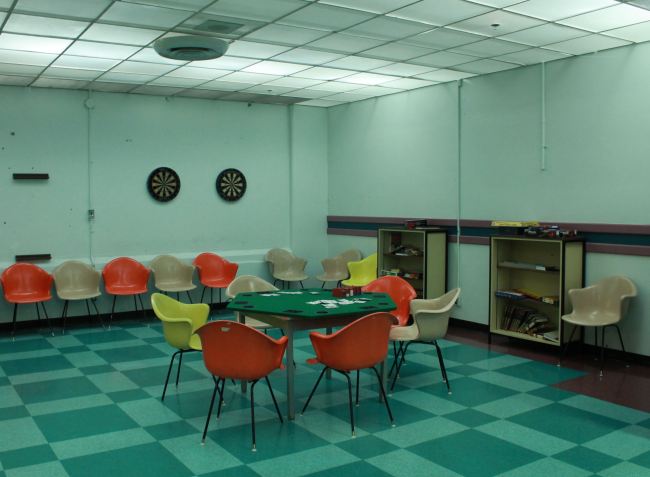
Card room in the cafeteria. Nearby is a large mural of a pristine river in Alberta to remind the doomed future-people of the before-time.
The Diefenbunker also features a cafeteria, which Cassie boasted was “the second best military kitchen in Canada,” and a deep freezer which doubles as a morgue. The most impressive room is the crazily secure Bank of Canada vault, where the nation’s gold would have been shipped in the case of an imminent crisis. A wedding ceremony was recently held in this very room, with a reception in the cafeteria. I can’t imagine anything more romantic. Joanna remarked that it would be the perfect spot for a post-apocalyptic prom.
Apart from weddings, the facility is also available for laser tag and a zombie apocalypse night. I asked Cassie whether she thought the bunker could withstand a real zombie attack. “If you could get in,” she replied. Then supplies would be the issue. None of the machines work and the freezer is full of plastic fruit and empty boxes. The only sustenance would be candy and novelty ration packs from the gift shop. How long could Joanna, Jenn and I hold out? “About a week,” Cassie predicted.
The ration packs didn’t seem very appetizing either. Cassie told us that “once a kid forgot his lunch and his mom bought him a ration pack and he cried cause it was so bad.” There are also “commie mints” and something called “space food,” but neither seemed to promise much nutritional value.
The Diefenbunker is, to put it mildly, completely incredible. And they do it on minimal funding, more or less neglected by the government and reliant on grants, admissions and donations to keep the place going. Cassie was well informed and a great storyteller, regaling us with all sorts of strange anecdotes. She told us about a similar bunker in Penhold, Alberta which wound up in the possession of a farmer who put it up for auction. The Hell’s Angels put in the highest bid. The government, anxious about a violent criminal enterprise gaining access to a high security compound, ended up buying it back for double the price.
The Diefenbunker handily takes the award for Ottawa’s most underrated museum. The guided tours are entertaining and informative and visitors have free rein to explore the facility’s four expansive levels. Very little is off limits and anyone with the least bit of interest in the cold war will find that almost every detail excites their curiosity.
I would also recommend the agriculture museum. Everyone I speak to seems to think the place is just for families with little kids, but I assure you that a dairy Holstein caressing your face with its slathering tongue is an experience you will not soon forget.
The Nepean museum may have been a bit out if its league, up against bigger/cuter/post-apocalyptic museums. Still, it’s a great place for people living in the community that are interested in local history. It’s well put together and they make an effort to change the exhibits regularly enough. Just be sure to go back to the storeroom and see the robot.
Direct Democracy in Montreal: a Casualty of Elections
March 31st , 2013
*Name has been changed due to agreement with source
Tuesday, in the basement of a housing cooperative in the Villeray neighbourhood of Montreal, 11 activists spent the evening discussing strategies to rekindle a dying movement. They are among the last remaining members of Villeray’s Autonomous Neighbourhood Assembly, a community group that once drew crowds of roughly a hundred to summer meetings in nearby Jarry Park, only to see its membership slowly wither away last fall.
A dozen or so neighbourhood assemblies sprouted up all over Montreal during the 2012 Quebec student strikes, which aimed to derail tuition increases proposed by Jean Charest’s provincial Liberal government. Local activists, inspired by the participatory approach adopted by Quebec’s student unions, sought to bring the principles of direct democracy to life in their communities. The neighbourhood assemblies they created were intended to provide an open forum of debate, where residents could get together and organize community initiatives. Most disappeared soon after the September elections that toppled the Liberals. Since the official end of the strike that month, only a few still bother to meet regularly or update their websites.
Bruno Tremblay*, a thirty-something computer scientist who grew up in Villeray, has been involved in the local assembly since July 2012. An easygoing man sporting a bright red T-Shirt stamped with a picture of a Molotov cocktail and the word “provocateur,” Mr. Tremblay is a staunch supporter of direct democracy. “People here need to be able to participate in decisions that affect their neighbourhood,” he says.
He recalls how Villeray’s assembly first formed to support the students and encourage the daily “casserole” protests, where hundreds of residents spilled into the streets banging on pots and pans to oppose Charest’s policies. From fighting for accessibility in education, the group has moved on to demanding more affordable housing in their slowly gentrifying community. But the campaigns it has organized to oppose rent increases have failed to repeat the success of the “casseroles.”
Mr. Tremblay is keenly aware of the assembly’s recent downturn, and speculates that the elections that ousted Charest played a role in dampening popular mobilization. Plans by the newly elected Parti Quebecois government to replace the tuition hike with a policy of indexation succeeded in satisfying moderate students while stopping short of the demands of activists and most student groups. In Mr. Tremblay’s view,”the elections put the masses to sleep,” simply replacing one bourgeois clique with another. Representative democracy will never respond to the problems ordinary people face, because it is nothing more than “a plutocracy where the economy and capital control the government,” he explains. For much of the radical left in Quebec, the neighbourhood assemblies offered an alternative, but they failed to capture the public’s attention for more than a fleeting moment.
Toronto’s Wannabe: the Spice Girls Tribute Band brought the 90s back to life at Zaphod Beeblebrox last Thursday. Describing the performance as “nostalgic,” “a throwback to my childhood” and “literally the greatest moment of life,” fans had no trouble convincing themselves that these five ladies were the real thing. “Girl power!” was on everybody’s lips, but what did it all really mean? Female empowerment, empty headed Brit-pop, or just a great night to party hard and go home with the drummer? Maybe all three?
Even out of costume, the alter egos of Anika Johnson, Suzy Wilde, Janée Olivia, Catharine Merriam and Barbara Johnston are pretty easy to pin down. Their distinctive attitudes clearly reveal who’s supposed to be Ginger Spice, who’s Posh, Baby and Sporty. With hair like that, Scary is kind of a dead giveaway.
Wardrobe and makeup take about four hours. Everything has to be perfect. As Anika says, “we want to stress that we take this very seriously.”
Two hours later, the girls emerge from the basement one by one, wearing wigs, knee-high platform boots, track pants, a leopard print gown, a glittering union jack onesie. They wade through a crowd of adoring fans who have suddenly reverted to where they left off in the fifth grade.
For just this one night, it’s 1996 all over again.
Forming two years ago for what was supposed to be a one-off gig, Wannabe has become a regular fixture at Toronto venues. This Thursday, rolling through Ottawa on their way from Stratford to Montreal, the group nearly filled up Zaphod Beeblebrox, energizing the audience with Brit-pop classics sung to the tune of a six piece rock band. It may not have been as big as Aaron Carter’s recent sold out show there, but bear in mind that Wannabe is not really the Spice Girls whereas Aaron Carter actually is Aaron Carter.
Opening with Wannabe, the girls went through a slew of hits, a wardrobe change and some crazy dance moves before playing a double encore of It’s Raining Men and Spice up your Life. Their performance was authentic, while the talented back-up band added a satisfying touch of rock n’ roll. As Barbara put it, “we’re like the Spice Girls meets the Stones.” The Stones may not have had a keytar, but I can definitely see her point.
In the eyes of much of the audience, the men in the band were a major attraction. The drummer was widely acknowledged to be the dreamiest, but the others got their fair share of attention. Hook-up-wise, being part of the back-up band in a Spice Girl’s tribute show is probably the best decision a man can make. My buddy Jenn, who came along to help me review the show, even overheard one young lady exclaim “OMFG I want him inside me… one of them needs to fuck me tonight!” While this might suggest a certain wanton desperation, a willingness to go home with any dude holding a musical instrument, I kind of admire her candor and brashness.
The show did have a few problems. The stage was way too small for eleven people, particularly when five of them are performing choreographed routines and one of them occasionally breaks out into the worm. Some of the props had to go, including the massive SPICE backdrop, which was a real shame. My buddy Jenn noticed that two of the girls were wearing identical boots, which were (gasp!) heavily scuffed. The volume on Posh’s mic was also a bit low. But seeing how much everyone was getting into the show, climbing up on tables to get a better glimpse of their favorite pop idols, I was willing to forgive the fashion faux pas and technical difficulties.
Girl Power: a feminist slogan?
For all five members of Wannabe, listening to the Spice Girls was a defining part of growing up in the 90s. The first CD Anika ever owned was Spice. She played it until it died.
“For our generation, the breakup of the spice girls is like your parents getting divorced,” says Barbara.
A lot of concertgoers felt the same way. Whoever I spoke to, the same words kept repeating themselves: “nostalgia,” “childhood,” “high school.”
“I feel like I’m reliving my childhood, only with a lot of booze in the mix,” says Erica Riley.
But beyond all the memories of a long-lost golden age, the Spice Girls represented one idea. Everybody knew what it was…
Girl power.
The Spice Girls are, of course, the biggest selling all-female act in history. They projected an air of confident independence and encouraged girls to put their friends, and themselves, before their boyfriends. While they may have ripped off the term from Riot Grrrl, the Spice Girls made girl power a reference point in the pop-culture psyche.
Still, it’s not easy to argue that the kind of girl power the Spice Girls were talking about was meant as a feminist message. The band was marketed to young girls in a relatively non-confrontational way, and their songs were anything but political.

During intermission the guitarist offered us a bunch of pills, ostensibly Rockets. I said I wasn’t hungry. Jenn ate one and didn’t die.
Jessica K. Taft, Assistant Professor of Sociology at Davidson College, argues that the Spice Girls were rejecting feminism altogether, offering their inoffensive brand of fashion focused pop individualism as an alternative. She quotes the band’s 1997 book, which states that “feminism has become a dirty word. Girl power is just a nineties way of saying it. We can give feminism a kick up the arse.”
I wouldn’t go so far as Ms. Taft. Saying girl power is “a nineties way of saying it,” indicates that the group was trying to rebrand feminism, not replace it, when it had failed to firmly entrench itself in the broader social consciousness. Let’s keep in mind that the Spice Girls were targeting 10 year old girls, who could hardly be expected to pick up a copy of Judith Butler’s Gender Trouble.
A recent article in Rookie, a web magazine for teenage girls, revaluates the contribution of the Spice Girls to female empowerment, and laments the wave of explicitly anti-feminist pop groups that followed, from the Pussycat Dolls to Taylor Swift.
“We were wrong about the Spice Girls. We were wrong about whether they ‘killed feminism’ by not representing our favorite kind” says the article. “We were scared that the Spice Girls would make feminism too mainstream and commercial. Well, good news: feminism is totally unpopular now, hurray!”
The role of the Spice Girls was to bring feminism out from gender studies departments, pro-choice demonstrations and Simone de Beauvoir reading circles and into the wider world. A heavily watered down form of feminism, sure, but it had to be digestible enough for the target audience.
What did girl power mean to the room full of fans who, a decade and a half after the Spice Girls broke up, crowded into Zaphod’s to take in the Wannabe concert?
Many just emphasized how much the Spice Girls made them comfortable demanding what they wanted, being free and not caring what society thinks about it. What came through even more clearly was that the group provided girls with role models, a way to feel represented in what had always been a male dominated music industry.
“The Spice Girls were the first band that I saw myself in,” says Trisha Davis. “That’s me in the media… that’s not just a boy I can lust after… I can pretend that I am that girl.”
Kids look to pop culture for their idols. The Spice Girls opened up a relatively diverse range of role models that young girls could identify with. Sure, the Spice Girls were thin, they were conventionally pretty and only one of them wasn’t white. But they still had individual personalities, and, between the five of them, seemed to present a wider range of possibilities than most pop groups since.
Feminism’s for Girly Girls too!
Admittedly, the Spice Girls played into a lot of stereotypes. Even if they were not all equally posh, all of them wore tight, revealing clothing and layers of make-up. While this certainly limits their revolutionary impact, it doesn’t mean that they shouldn’t be taken seriously, or that they can’t be conveying a feminist message. As Baby Spice once put it, “Just because you’ve got a short skirt on and a pair of tits, you can still say what you want to say.”
The girls from Wannabe made a similar statement.
“Women can be sexual and also be intelligent and decide how they want to be portrayed,” says Anika. While girls shouldn’t feel that they have to look sexy to make it in the world, they also shouldn’t feel like they have to reject everything traditionally “girly” to be proper feminists.
“Why shouldn’t we want to dress up and do make up, and why can’t we also have an intelligent discussion over cigars and brandy,” asks Barbara. “That’s what real feminism is, it’s whatever you want it to be and it’s not up to anyone else to tell you what that is.”
As far as I’m concerned, the young lady who wanted to shag anyone in the back-up band could have been just as much a feminist as anyone else. Why not? I bet most of the few straight men at the show would happily have gone home with any of the ladies on stage. And I doubt any of those guys felt disempowered or cheap because of it. Why should she?
So maybe that’s what empowerment means: having the choice to wear platform boots or combat boots, to go home alone or backstage with the drummer, and, whatever it is you choose, to still be respected for it. That’s girl power.
XXX Video Rental in the Internet Age
Catering to an aging clientele and forced to compete with easily accessible internet pornography, many adult video shops are finding they must reinvent themselves to survive. I visited Carlington’s Pleasures N’ Treasures to see what they’re doing to adapt.
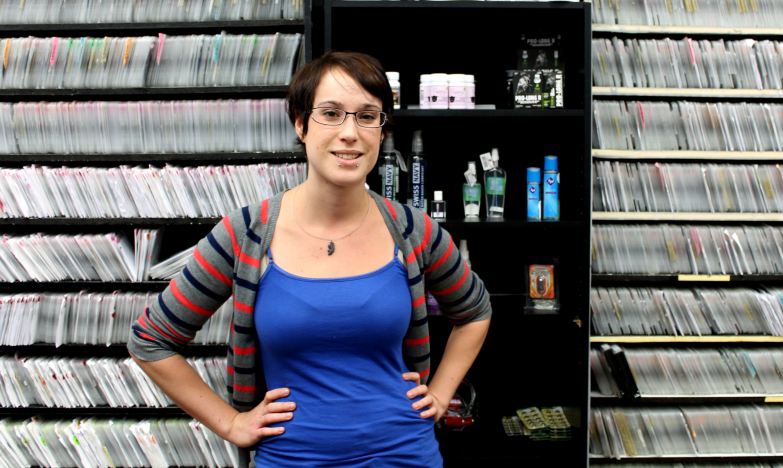
Kirstyn Seanor – she said that the strangest part of working in a porn shop is explaining to people that you don’t carry bestiality porn because it’s illegal. This has happened to her twice.
Pulling up to what had long been the “Adult Video Warehouse” on Carlington’s gritty section of the Merivale strip, I was dismayed to see the words “Pleasures N’ Treasures” printed tastefully on the front of a remodeled façade. Along with three friends, I was hoping to review some of Ottawa’s sketchiest porn shops, the sort with humming black lights and mysterious ceiling stains. When I walked into a brightly lit space whose laminate flooring had just been lovingly scrubbed by a clean-cut twenty-something, I felt deprived of the borderline experience I was expecting.
Setting out in search of a feature length film with a good storyline and as much bizarreness as possible, we found the selection more encouraging than the squeaky clean interior first seemed to suggest. Nearly every niche genre with a category on youporn was well represented: POV, mature, vintage, watersports, TV parodies like The Sex Files and a disturbingly carnal rendition of the Cosby Show. There were even hours upon hours of vegetable insertions and labial pumping for those with more particular tastes.
Even though my review team, consisting of a lesbian couple and a sitting member of the youth advisory committee of a social justice camp for LGBTQIA+ adolescents, fell well outside the target audience, we mostly confined ourselves to the straight side of the store. Rhube was dealing with a recent breakup, and feared that man-on-man sex would rekindle painful memories. Jenn’s passion for Batman and the female buttocks helped us narrow down our choices, and we walked away with Batman XXX: a sex parody, a two disc, five hour epic entitled Evil Anal and Librianna: bitch of the black sea. That last one was my personal selection, a 1979 portrayal of the daring exploits of a Russian sex-queen determined to bring about the fall of communism through wanton debauchery. Not bad for $9 plus tax.

Rhube, Jenn and Joanna considering candidates for our triple feature. All three were rejected, although Debbie duz Dishes definitely felt like a winner.
I asked Kristyn Seanor, 24 and employed at Pleasures N’ Treasures for the past year, what happened to the adult video warehouse, and why anyone would bother leaving their home when immediate sexual gratification is only a mouse click away.
“Most of our regulars are men over 40… we don’t get a lot of young people unless they’re renting a parody for a movie night,” she explained. While many customers prefer the higher quality of rented videos, others are unable, unwilling or simply afraid to adapt to the world of internet pornography.
Still, with the prospect of more and more regulars passing on to the big porn shop in the sky, the store’s management recognize that they cannot rely on their core clientele indefinitely. The name change and redesign are part of a rebranding effort, aimed to appeal to a wider, younger audience.
“Even a few years ago we had black walls, it all looked a bit depressing and seedy,” says Ms. Seanor. “We’ve tried to clean up to make it more accessible and approachable.” While the store still relies primarily on its male client base, “a big part of rebranding was becoming more female friendly, more couple friendly, and just diversifying what’s available,” she explains. Porn remains the main money maker, but now shares the space with lingerie, costumes and sex toys.
Hitting the internet right where it hurts, staff have begun running a blog featuring the best and worst recent porn titles, including the aptly named “My mommy got divorced and had sex with a black man with a huge cock.” Kudos to the production company for letting us know exactly what we’re in for.
Despite the general scariness of the neighbourhood, both of my female friends felt pretty comfortable in the store. Between Batman XXX and Librianna, we all found something that appealed to us, suggesting that the store’s new marketing strategy might pay off. We’ll be sure to stay tuned into the store blog so we don’t miss the next blockbuster.
After my rental experience, I had to agree that XXX video shops still have a role to play in the 21st century porn market. It was nice to have a real human being behind the counter, able to respond to my slew of strange questions in a completely non-judgmental way. After a short discussion with Kirstyn, labial pumping doesn’t seem quite so weird anymore. In a world where pornography is often seen as marginal, antisocial and shameful, a welcoming place filled with supportive and positive people goes a long way toward making it a perfectly normal experience. Those elderly luddites, picking up an old favorite after an afternoon spent at the legion, seem to have it all figured out. Maybe all of us should get off our computers and visit our friendly neighbourhood smut merchant.
